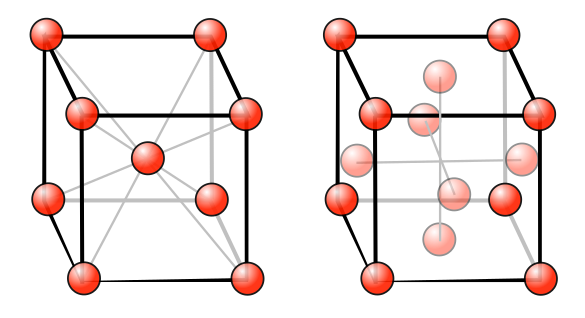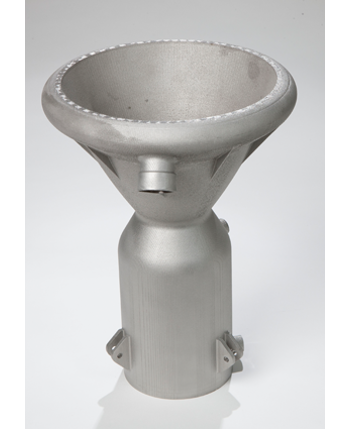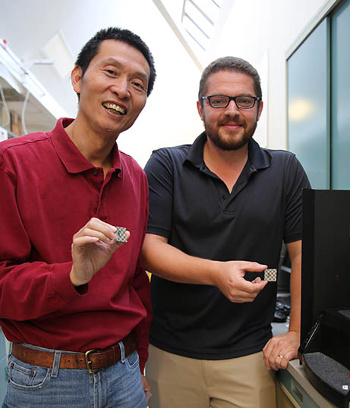3D-printing Stainless Steel
December 11, 2017
The door of our current
refrigerator is
stainless steel. It's good that our
children are grown, since everyone knows that an important function of a refrigerator door is to hold children's
drawings. This is usually accomplished with
refrigerator magnets, and the stainless steel door of our refrigerator is
non-magnetic, so
magnets don't stick.
While stainless steels, like other
steels, have a high
concentration of
iron, the particular stainless steel used for our refrigerator must be an
austenitic stainless steel, which means that the
atoms are arranged in a
face-centered cubic (FCC) crystal. There's another type of stainless steel,
ferritic stainless steel, in which the atoms are arranged as a
body-centered cubic (BCC) crystal. Ferritic stainless steel has the same BCC crystal structure as iron, and it is also magnetic.

body-centered cubic (BCC) and face-centered cubic (FCC) crystal structures.
(Created using Inkscape. Click for larger image.)
Refrigerator stainless steel is generally
ANSI type 304, also known as "18-8" since its
chemical composition is 18 percent
chromium and 8 percent
nickel with the balance as iron, plus a pinch of
manganese,
carbon and
nitrogen. The
400 series contain no nickel, and those alloys are magnetic. One contributing factor to 304 stainless steel having the FCC crystal structure is that nickel is FCC in its
elemental form.
Why is the FCC form of stainless steel non-magnetic, while its BCC form is? The first reason relates to the number of
electrons needed to
bond the atoms together in the
crystal. Electrons involved in the bonding cannot contribute to magnetism. Magnetism in
transition metals arises from their
d-electrons. It takes about two more electrons to bond an FCC crystal together than a BCC crystal, so we lose two of the
d-shell magnetic electrons.
Magnetic atoms also communicate their magnetic state to each other via an
interaction known as the
exchange field. The exchange field is responsible for the
alignment of electron spins that results in magnetism. This exchange interaction depends on the distance between atoms, and this distance is different in the BCC and FCC forms of stainless steel.
Stainless steel was discovered quite
accidentally by
English metallurgist,
Harry Brearley (1871-1948). Brearley was doing routine testing of different alloys to find ones with high
erosion resistance. He noticed that his pile of rejected
samples had all
rusted, except for one containing
chromium.

Photo of English metallurgist, Harry Brearley (1871-1948), from a monument at the former Brown Firth Research Laboratories, Sheffield, England.
Brearley discovered stainless steel, supposedly by accident.
(Wikimedia Commons image by David Morris, modified for artistic effect.)
Most
physics and
analytical chemistry laboratories contain numerous
vacuum systems fabricated from
type 316 stainless steel. Stainless steel is a common material in
surgical instruments,
dental instruments, and other
medical equipment, since it can be
sterilized in an
autoclave. Stainless steel is a common material in
kitchen appliances, since it is rugged, durable, heat resistant, and it can be cleaned easily.
Cutlery is generally made from stainless steel for these same reasons. Because of its low
thermal conductivity, stainless steel
cookware needs to be fabricated as a thin
cladding over a thick core of
aluminum or
copper.
As one who has
machined stainless steel pieces, I can verify that stainless steel is a
hard material with which to work. The
Rockwell hardness (B-scale) of type 304 is slightly less than 90, while type 318 is slightly more. Compare this with the value for
mild steel, about 70,
brass, about 55, and aluminum, about 60. In any case, it makes more sense to eschew machining and fabricate complex components additively by a
powder metallurgy method such as
metal injection molding.
Unfortunately, powder metallurgy has a
sintering step that caused shrinkage of a powder compact. Machining is still required to achieve close
tolerance, the
density of a component is a few percent less than that of a
cast part, and the
mechanical properties of the material are not as good as those of a cast part. A team of
materials scientists and
mechanical engineers from
Lawrence Livermore National Laboratory (Livermore, California), the
Georgia Institute of Technology (Atlanta, Georgia),
Ames Laboratory (Ames, Iowa), and
Oregon State University (Corvallis, Oregon) has developed a
laser powder-bed-fusion technique for additive manufacturing of
type 316L stainless steel.[1-3] This process can produce
mechanically tough components for conditions in
marine,
aerospace,
automotive, and other harsh
environments.
The targeted material for this process was 316L "
Marine grade" stainless steel, which resists
corrosion and is highly
ductile. This
alloy is used in such applications as
oil pipelines,
welding, kitchen utensils,
chemical equipment,
medical implants,
engine parts and
radioactive waste storage.[2] Conventional techniques for strengthening this alloy typically reduce its ductility.[2]
To make the 3D-printed steel perform as well as cast material, it was necessary to reduce
porosity in the laser-fused metal powders.[2] The
research team addressed the porosity problem through a density
optimization process involving manipulation of the materials
microstructure guided by
computer simulation and confirmatory
experiments.[2] Thin plates of 316L stainless steel were prepared for
mechanical testing by placing a powder layer of metal alloy particles on a flat platform,
raster-scanning the surface with a high-powered laser beam, lowering the platform, and repeating the steps. A sufficient number of steps produces complex shapes, such as
rocket engines (see figure).[3]

Rocket engine fabricated with a powder-bed-fusion additive manufacturing process.
This engine, a prototype for the NX-01 Nanosat Launch Vehicle, took eight days to create at a cost of $10,000. This is at least an order of magnitude less that conventional fabrication.
(LLNL image.)
The
computer-controlled process allows a tight control the microstructure of the material for a beneficial effect. Tests showed that the 3D printed stainless steels could attain up to three times the
strength of steels made by conventional techniques and still have ductility.[3] Says
Morris Wang, a LLNL materials scientist and lead
author of this research,
"In order to make all the components you're trying to print useful, you need to have this material property at least the same as those made by traditional metallurgy... We were able to 3D print real components in the lab with 316L stainless steel, and the material's performance was actually better than those made with the traditional approach. That's really a big jump. It makes additive manufacturing very attractive and fills a major gap."[2]

Morris Wang (left) and Thomas Voisin of LLNL.
Wang and Voisin were members of the research team that developed 3D printing of the marine-grade 316L stainless steel.
(LLNL image.)
As LLNL
scientist,
Alex Hamza, describes it, the 3D-printed 316L has an interesting
grain structure, with relatively large grains that contain cellular structures and other
defects. There was a
hierarchically heterogeneous microstructure, with length scales spanning nearly six orders of magnitude.[1] Says Hamza, "We didn't set out to make something better than traditional manufacturing; it just worked out that way."[2] The
yield strength and
tensile ductility surpass those of conventional 316L steels.[1]
Since the LLNL process used a
commercially available 3D printer and laser, it will be easy for others in industries such as aerospace, automotive, and oil and gas to create their own components.[2-3] The technique might be applied to create components from other alloys that are
brittle and prone to
cracking.[2]
References:
- Y. Morris Wang, Thomas Voisin, Joseph T. McKeown, Jianchao Ye, Nicholas P. Calta, Zan Li, Zhi Zeng, Yin Zhang, Wen Chen, Tien Tran Roehling, Ryan T. Ott, Melissa K. Santala, Philip J. Depond, Manyalibo J. Matthews, Alex V. Hamza, and Ting Zhu, "Additively manufactured hierarchical stainless steels with high strength and ductility," Nature Materials, Article No. 5021 (October 30, 2017), doi:10.1038/nmat5021.
- Jeremy Thomas, "Lab researchers achieve breakthrough in 3D printed marine grade stainless steel, LLNL Press Release, October 30, 2017.
- Robert F. Service, "3D printing doubles the strength of stainless steel," Science, October 30, 2017.
- 3D printing metal parts and novel materials, LLNL Web Site.
- Metal Additive Manufacturing, LLNL Web Site.
- Additive Manufacturing: The dawn of a new industrial revolution, YouTube video by Lawrence Livermore National Laboratory, September 5, 2013.
Linked Keywords: Refrigerator; stainless steel; child; children; drawing; refrigerator magnet; magnetic field; magnetic; magnet; steel; concentration; iron; austenitic stainless steel; atom; face-centered cubic (FCC) crystal; ferritic stainless steel; body-centered cubic (BCC) crystal; crystal structure; Inkscape; American National Standards Institute; ANSI; type 304; chemical composition; chromium; nickel; manganese; carbon; nitrogen; 400 series; chemical element">element; electron; chemical bond; crystal; transition metal; d-electron; d-shell; exchange interaction; exchange field; spin polarization; alignment of electron spins; serendipity; accident; English people; metallurgy; metallurgist; Harry Brearley (1871-1948); erosion resistance; sample; rust; chromium; monument; Brown Firth Research Laboratories; Sheffield, England; Wikimedia Commons; physics; analytical chemistry; laboratory; vacuum chamber; vacuum system; surgical instrument; dental instrument; medical equipment; sterilization (microbiology); sterilize; autoclave; kitchen appliance; cutlery; thermal conductivity; cookware; cladding (metalworking); aluminum; copper; machining; machine; hardness; hard; Rockwell hardness; mild steel; brass; powder metallurgy; metal injection molding; sinter; sintering; engineering tolerance; density; casting; cast; mechanical property; materials scientist; mechanical engineers; Lawrence Livermore National Laboratory (Livermore, California); Georgia Institute of Technology (Atlanta, Georgia); Ames Laboratory (Ames, Iowa); Oregon State University (Corvallis, Oregon); laser; powder-bed-fusion; type 316L stainless steel; toughness; mechanically tough; sea; marine; aerospace; automotive; environment; Marine grade stainless; corrosion; ductility; ductile; alloy; oil pipeline; welding; chemical; medical implant; engine; radioactive waste storage; porosity; research; optimization; microstructure; computer simulation; experiment; mechanical testing; raster scan; raster-scanning; rocket engine; prototype; Nanosat Launch Vehicle; order of magnitude; computer-control; strength of materials; Morris Wang; author; Thomas Voisin; scientist; Alex Hamza; crystallite; grain; crystallographic defect; hierarchy; hierarchical; heterogeneous; yield strength; tension (physics); tensile; commercially available; brittleness; brittle; fracture; cracking.